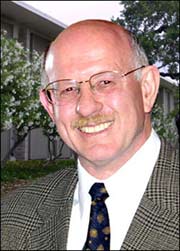
Handy Links
SLAC News Center
SLAC Today
- Subscribe
- Archives: Feb 2006-May 20, 2011
- Archives: May 23, 2011 and later
- Submit Feedback or Story Ideas
- About SLAC Today
SLAC News
Lab News
- Interactions
- Lightsources.org
- ILC NewsLine
- Int'l Science Grid This Week
- Fermilab Today
- Berkeley Lab News
- @brookhaven TODAY
- DOE Pulse
- CERN Courier
- DESY inForm
- US / LHC
SLAC Links
- Emergency
- Safety
- Policy Repository
- Site Entry Form

- Site Maps
- M & O Review
- Computing Status & Calendar
- SLAC Colloquium
- SLACspeak
- SLACspace
- SLAC Logo
- Café Menu
- Flea Market
- Web E-mail
- Marguerite Shuttle
- Discount Commuter Passes
-
Award Reporting Form
- SPIRES
- SciDoc
- Activity Groups
- Library
Stanford
Around the Bay
Dorfan Today: New Concepts in Hamburg
 The major annual meeting of the International Linear Collider (ILC) project has become a family reunion of sorts, as now-familiar faces gather together to advance the project.
The major annual meeting of the International Linear Collider (ILC) project has become a family reunion of sorts, as now-familiar faces gather together to advance the project.
Some 600 people, including a strong SLAC contingent, met in Hamburg, Germany during a surprisingly rainless week from May 30 to June 3. Our hosts from DESY laboratory put on wonderful events during the meeting, including a memorable and excellent banquet at Hamburg's historic zoo.
With both the Reference Design Report and the Detector Concept Report under its belt, the collaboration made major forward progress at the Hamburg meeting in preparing to enter the Engineering Design phase. On the accelerator side, the engineering work will be overseen by a newly formed Project Office run by three project managers: Marc Ross of Fermilab (and formerly SLAC), Nick Walker of DESY, and Akira Yamamoto of KEK. ILC working groups met to discuss results and plan further R&D, and they gave input to the Project Office on ways to organize the collaboration during the engineering phase that will culminate in an Engineering Design Report in 2010.
On the detector side, major shifts occurred. The Worldwide Study, a group from the detector and physics communities that oversees detector R&D and detector concept studies, set a roadmap for detector development that will allow the community to deliver engineering designs for two detectors in 2010. In the first step, the ILC Steering Committee (ILCSC) will issue a call this summer for Letters of Intent (LOI). Groups have until the summer of 2008 to submit letters detailing their detector concept and performance. Calling for LOIs signals a phase change for the detector concepts, detector “Design Studies” will soon become “Detector proto-collaborations.” Calling for LOIs also sends signals to the ILC detector R&D community that now’s the time to align with a detector concept, participate in the optimization process, and contribute to the LOIs. The process is accelerating rapidly.
A new committee, the International Detector Advisory Group, will review the LOIs and advise and guide the detector groups toward delivering two complementary detectors for ILC. In another major development, the ILC is now looking for a Research Director to oversee the experimental program, guide high-level detector decision making and help secure funding for detector engineering designs. The ILCSC established a committee to help bring the concept of a Research Director to fruition.
During the meeting, two of the major detector concepts, the LDC and the GLD, began coalescing into a shared concept. The other two concepts—SiD, which SLAC physicists help lead, and the Fourth concept—are ramping up their efforts to engage more people in their collaborations. R&D reviews during the meeting evaluated the various proposed calorimetry subsystems.
The momentum for the ILC is continuing to grow. The Hamburg meeting was especially exciting as the detector community now has a definite plan together with milestones to have detector designs of a maturity similar to that of the accelerator by 2010.
—Jonathan Dorfan, June 11, 2007